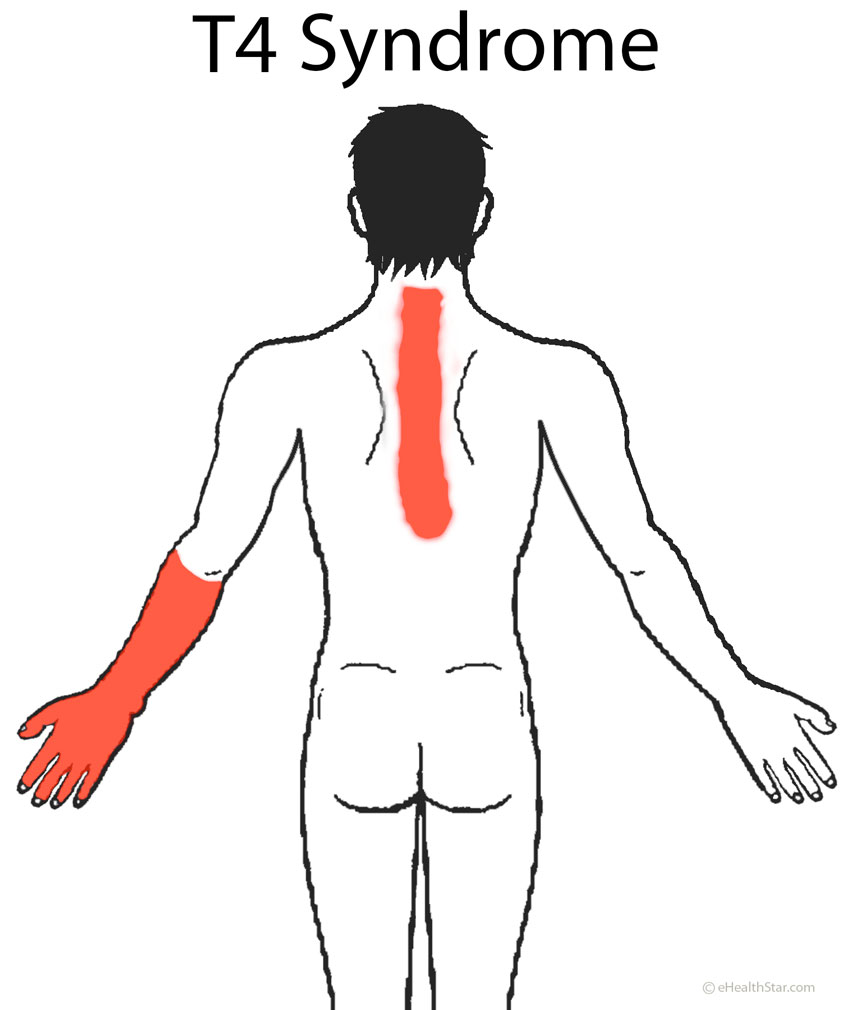What is T4 or upper thoracic syndrome?
Upper thoracic syndrome is a rare condition with irritation of the joints in the upper thoracic spine (between the vertebrae T2 and T7) and nearby sympathetic nerves resulting in pain between the shoulder blades and arms [1,4]. Originally, it was thought that only the 4th thoracic vertebra was involved – from here the name T4 syndrome [4].
Causes
Causes of the upper thoracic syndrome include [3]:
- Poor posture or repetitive forward, backward and sideways bending or twisting of the trunk, for example, in dentists, surgeons, electricians, assembly-line workers, cyclists, drivers, computer workers or students
- Carrying heavy backpacks
- An injury to the upper back
Symptoms
Upper thoracic syndrome most commonly occurs in women after 35. Symptoms include [1,3,4,6]:
- Abnormal sensations (paresthesiae): a sense of swelling, puffiness and extreme perception of cold and heat, excessive sweating, numbness and tingling in the glove pattern in the hand, all 5 fingers and forearm, on one or both sides (Picture 1)
- Hand clumsiness
- Symptoms that may or may not be present:
- Diffuse, sharp, stabbing or crushing pain between the shoulder blades and upper arms
- Headache at the back of the head
- Neck stiffness or chest tightness
Symptoms tend to be worse at night, in the morning or after prolonged sitting in a hunched position and can be triggered by quick upper body movements, deep breathing, coughing and changing position in bed [1,2,3]. Pain in the back can be relieved by lying flat (without a pillow) on the back [1] and the symptoms in the arm by shaking the arm [2].
Dizziness and nausea do not typically occur in T4 syndrome.
Diagnosis
There are no clear diagnostic criteria for the upper thoracic syndrome, so the diagnosis is made after other similar conditions have been ruled out [4]. During the physical examination, a doctor can find the following signs [1,4]:
- Increased curvature of the neck (cervical lordosis)
- Decreased curvature of the upper back (flat upper thoracic spine)
- Tenderness over the thoracic spine
- Decreased range of motion in the neck and thoracic spine
Imaging investigations (X-ray, CT, MRI) are not helpful in a diagnosis [1,3].
Differential Diagnosis
Conditions with similar symptoms than the upper thoracic syndrome [1,4]:
- Conditions with pain between the shoulder blades:
- Myofascial pain syndrome with muscle knots
- Muscle strain
- Rheumatoid arthritis
- Ankylosing spondylitis
- A herniated disc in the cervical or thoracic spine
- Facet joint syndrome
- Vertebral fracture
- Other conditions with upper back pain:
- Fibromyalgia
- Intercostal neuralgia
- Coronary heart disease; angina pectoris, heart attack
- Conditions with abnormal sensations and pain in the forearms and hands:
- Carpal tunnel syndrome
- Cubital tunnel syndrome
- Guyon’s canal syndrome
- Thoracic outlet syndrome
- Multiple sclerosis
- Complex regional pain syndrome
- Conditions with numbness in the fingers, such as Raynaud’s phenomenon and peripheral neuropathy
Treatment
An experienced physiotherapist can perform manual therapy and teach you how to improve posture and perform exercises at home [1,3,4].
Anti-inflammatory medications and injections of local anesthetics may reduce pain [3,5].
Recovery Time
With appropriate treatment, T4 syndrome symptoms can resolve within few days to 3 months [4].
- References
- Richardson E, T4 syndrome ShoulderDoc
- DeFranca GG et al, 1995, The T4 syndrome PubMed
- T4 syndrome Physiopedia
- Karas S et al, 2016, T4 Syndrome: A Scoping Review of the Literature Academia.edu
- Mellick GA et al, 2006, Clinical presentation, quantitative sensory testing, and therapy of 2 patients with fourth thoracic syndrome PubMed
- Gaines J, 2016, THE THORACIC FOUR SYNDROME: A CASE REPORT AND NEW INSIGHTS IN PATHOPHYSIOLOGY, DIAGNOSIS AND TREATMENT IAOM-US


